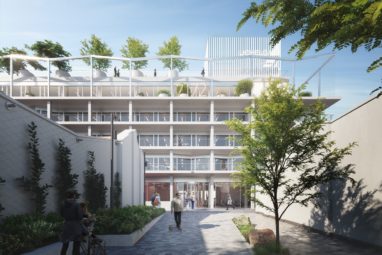 Written by:
Written by:
John Jackson
Industry Editor
With a clear strategy our High Streets can repurpose themselves to embrace the future and retain their place at the heart of our built environment.
The High Street has been at the heart of our urban centres from the very time people started to live in towns and cities. Of course it can be more than one street, but in essence they originally developed at a time when we didn’t have cars, superstores, retail parks or the internet. So the High Street was where people went for all their needs, including shopping, banking, socialising, getting things repaired, and enjoying cultural experiences.
Historically, many of our High Streets experienced some of their most significant changes as part of the post war rebuilding programme. This included the introduction of pedestrianisation, and also coincided with a time when office work became more commonplace, and as a result High Streets welcomed a daily influx of workers.

The traditional High Street model worked well until the 1980s, when ironically we were encouraged to embrace consumerism and strive for more aspirational lifestyles. Whilst initially we saw the development of shopping centres in our town and city centres, change was on the horizon with the arrival of large scale out of town retail, beginning in1986 with the opening of the 2 million sq ft Metrocentre in Gateshead, that came complete with some 15,000 parking spaces. In Wales we haven’t had this type of major regional shopping centre, although undoubtedly the Trafford Centre on the outskirts of Manchester will have attracted customers from across North Wales, and as “retail therapy” became a “thing” travelling to one of the many retail parks across the UK will have taken consumer spending out of our High Streets.
However, a more direct impact on our traditional High Streets has been the growth in edge of town retail parks, these developments are typically home to small selection of high street chain stores and are often anchored by one of the major supermarkets. Significantly they offer free parking and tend to be in locations that are easily accessible for car drivers.
This has meant we’ve seen a significant increase in the number of shops all bidding for our money, and now we have to also factor in the Internet which has taken consumer choice to a whole new level. I think it’s fair to say we have too much choice, and this was already evident before we faced the impact of the pandemic with a number of big name retailers shutting up shop or radically reducing their physical presence. Part of the issue for the chain stores has been the level debt they’ve carried, this was fine when the business could keep growing, and no doubt was a key factor in choosing to open in the increasing number of retail parks. Although currently this business model is under extreme strain, and unfortunately I don’t think any of us will be surprised if more big name retailers keep closing their doors.
However, our High Streets will still be there, and they will continue to have an important role to play in the future of our towns and cities, for the simple reason they are the logical and convenient place for people to come together. As people we are, in the main, social creatures who enjoy interacting with each other – it's natural and good for our wellbeing, and this is where we have the opportunity to create the people centric High Streets of the future. We’re already seeing this happen with increasing locations adopting the principles of placemaking to create urban environments that are intrinsically attractive locations to spend time in. I’ve previously discussed this with James Brown from the Urbanists in a conversation you can watch here.
In broad terms this should see High Streets become less congested with traffic, and in cases completely traffic free. Nature will be introduced to physically make our High Streets greener and depending on location amenities added to enhance time spent in our urban centres. This transformational approach is in alignment with the Welsh Government’s Active Travel Plan for Wales and is consistent with the approach being promoted by the Future Generations Commissioner for Wales in the recently published Manifesto for the Future. In essence we have a top level plan for the future of our High Streets, and this provides a sustainable basis from which the physical environment itself can be used to attract people.
This future for our High Streets could include:
- Larger retail units being divided into smaller ones to appeal to a wider variety of business
- Encouraging more local businesses to set-up shop, including helping very small traders to open and run shops cooperatively with others to reduce the overheads
- Focussing on creating High Streets where you can buy all the things you can’t buy on the internet. Including: hairdressers, wellbeing services, tattoo parlours, cafes, hand made products etc. Many of which are ideally suited to be run as small independent businesses
- Seeing small successful online businesses opening a High Street store to become a physical representation of the brand. This would help to strengthen credibility with online customers and at the same time provide the perfect backdrop for social media posts.
- Offices with the potential to be converted into apartments would allow increasing numbers of people the opportunity to live on or near the High Street, and as a result generate extra demand for the shops, cafes, bars etc in the area. This also creates an opportunity for urban regeneration specialists, Housing Associations and councils to develop these much needed new homes.

This list could be much longer, however that would run the risk of it being prescriptive and as our High Streets have differing characteristics it is important to ensure these are taken into consideration as part of any plans to repurpose them for the future.
With this in mind, Cllr Rob Stewart, Leader – Swansea Council Leader explains how the City has planned, as part of its urban regeneration programme, to ensure a healthy future for the High Streets in its urban core, Cllr Stewart said: “Led by Swansea Council and supported by the Swansea Bay City Deal, the private sector and other organisations including the Welsh Government, Swansea city centre is currently undergoing its biggest regeneration in many decades.
“The Shaping Swansea regeneration programme will lead to a 21st century working, living and leisure destination with facilities including new retail units and a new indoor arena combining with new green spaces, accommodation and office developments on streets including the Kingsway to generate more footfall for the benefit of existing businesses.
“Key to our plans is further support for high streets in the urban core of our city centre. This includes the High Street area, which has benefitted from a renaissance in recent years through innovation and the transformation of properties into facilities including coffee shops, art galleries, restaurants, bars and an independent cinema.
“These facilities have largely been driven by the entrepreneurship of local businesspeople, so our plans are aimed at complementing their hard work, while considerably boosting footfall to facilitate further spending and investment.
“High-quality connectivity has been introduced in the city centre to ensure our businesses are equipped to keep pace with digital innovation, but we’re also mindful of preserving the city centre’s rich heritage and individuality.
“This is why we will continue to invest in our historic indoor market, while doing all we can to further regenerate high streets in our city centre’s urban core, as well as High Street itself, which acts a key gateway in and out of the city centre for pedestrians and motorists.
“These plans will help accelerate the city centre’s economic recovery from Covid-19 for the benefit of local residents, businesses and visitors to Swansea in coming years.”
In uncertain times it can be all too easy to think the future for our High Streets is bleak, however the approach being taken by Swansea is an encouraging example of a city acknowledging the need to reset its urban core to ensure it becomes a highly attractive place for people to live, work and enjoy spending time in. Across Wales our urban centres have their own unique characteristics and challenges, however by adopting a strategic placemaking based approach to regeneration will help to ensure a healthy and resilient future for all of our High Streets.













